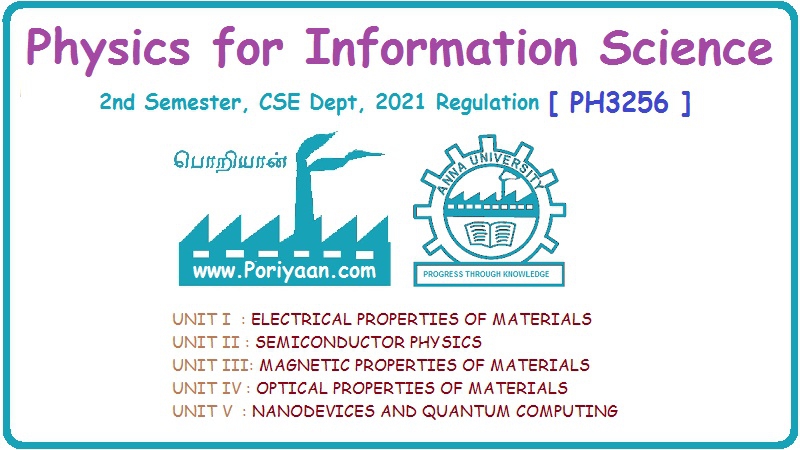Physics for Information Science: Unit II: Semiconductor Physics
(i) Intrinsic Semiconductor
A semiconductor in a extremely pure form is called as intrinsic semiconductors.Examples: Germanium and Silicon.
INTRINSIC
SEMICONDUCTOR
A
semiconductor in a extremely pure form is called as intrinsic semiconductors.Examples: Germanium and Silicon.
We
know Germanium and Silicon are the two important pure (or) intrinsic
semiconductors used in the manufacture of transistor and other semiconductor
electronic devices. Both these materials are crystalline in nature.
We
know the atomic number of Germanium is 32 and for silicon it is 14.
Electronic
configuration of
Ge→
1s2 2s2 2p6 3s2 3p6 3d10
4s2 4p2
Si→
1s2 2s2 2p6 3s2 3p2.
In
both these cases the number of valence electrons = 4. The other electrons
are
bound to the central positive core of the atom.
Let
us consider two atoms of Germanium brought closer to each other. Now the
positive core of one atom interacts with one of the electrons from the other
atom and the two electrons are shared by two atoms. These electrons are called
Electron Pairs.
When
the attractive force is balanced, by the repulsive force between the two
positive cores, a covalent bond is formed.
Explanation
In
the case of Germanium or Silicon we have 4 valence electrons. It is the
tendency of each germanium atom to have 8 electrons in the outer most shell. To
do so, each germanium atom arranges itself between four other germanium atoms
as shown in Fig. 2.1.
Here,
neighboring atoms shares one valence electron with the central (main atom
considered) atom. So, by this sharing, the central atom completes its last
orbit by having 8 electrons. In this way, the central atom sets up covalent
bonds (or) electron pairs, represented by curved dotted lines connecting the
atoms.
Hence
all the four valence electrons of the central atom gets tightly bound to the
nucleus. Similar such bonding occurs among all the other atoms giving rise to
extremely stable structure and hence has low conductivity (in pure form).
A
three dimensional view of Ge, crystal lattice shows that each atom is
surrounded symmetrically by four other atoms forming a Tetrahedral crystal as
shown in Fig. 2.2.
Both
Si and Ge are referred to tetravalent atoms: tetrahedral crystal. So, both Ge
and Si are called covalent solids.
Note:
Similar diagram and Explanations holds good for silicon also.
In
these semiconductors the electrons and holes can be created only by thermal
agitation. As there are no impurities the number of free electrons must be
equal to the number of holes.
At
OK the valence band is completely filled and the conduction band is empty. The
carrier concentration (i.e.,) electron density (or) hole density increases
exponentially with the increase in temperature.
Effect of Temperature on Intrinsic Semiconductors
The
electrical conductivity of a semiconductor changes appreciably with temperature
variations.
(i) At Absolute Zero:
At absolute zero, all the electrons are tightly bound to the nucleus (i.e.,).
The inner orbit electrons are bound, whereas the valence electrons are bonded,
with covalent bond, with other atoms. Hence there won't be any free electrons
and the semiconductor crystal behaves as a perfect insulator.
Hence
at absolute zero, no valence electron can reach the conduction band to become
free electron. Therefore the valence band is completely filled and the
conduction band is empty (Fig. 2.3).
(ii) Above Absolute Zero:
When the temperature is raised some of the co-valent bonds break due to thermal
energy supplied. Due to the breaking of bonds the electrons are released from
the co-valent bonds and become free electrons. Now, if a potential difference
is applied across the semiconductor, these free electrons moves with respect to
field direction and produces a tiny electric current as shown in Fig. 2.4.
This
shows that the resistance of semiconductor decreases with the rise in
temperature (i.e.,). It has Negative temperature Co-efficient of Resistance.
From
the energy band diagram as shown in Fig. 2.5, each time when a valence electron
becomes free and enter into the conduction band, a hole is created in the
valence band. Therefore the number of electrons that move to conduction band
will be exactly equal to the number of holes created in the valence band.
Hole Current
Similar
to the normal current which is due to free electrons another current called the
hole current also flows in the semiconductor.
Due
to thermal energy if one electron enters conduction band from valence band, one
hole is created in the valence band. Due to thermal energy hole-electron pairs
are created. [Hole → virtual Charge].
Let
us consider a valence electron at 'L' has become free electron due to thermal
energy and a hole is created at 'L' as shown in Fig. 2.6.
Since,
it is the tendency of semiconductor to form covalent bonds, a hole will attract
an electron from the neighbouring atom, say an electron from 'M' fills 'L'
position. Hence a hole is created at 'M'. Another valence electron (say at N)
fills the hole at 'M' thus creating a hole at N similarly hole, moves from L to
M, M to N, N to P, P to Q etc (i.e.,) towards the negative terminal of supply
voltage. This constitutes hole current.
Definition:
It is noted that hole current is due to the movement of valence electrons from
one covalent bond to another bond [not by the free electrons in conduction
band].
Thus
it is clear that the valence electrons move along the path NML, whereas holes
move in the opposite direction. (i.e.,) along the path L→M→N etc as in Fig.
2.7.
Physics for Information Science: Unit II: Semiconductor Physics : Tag: : - (i) Intrinsic Semiconductor
Related Topics
Related Subjects
Physics for Information Science
PH3256 2nd Semester CSE Dept | 2021 Regulation | 2nd Semester CSE Dept 2021 Regulation
